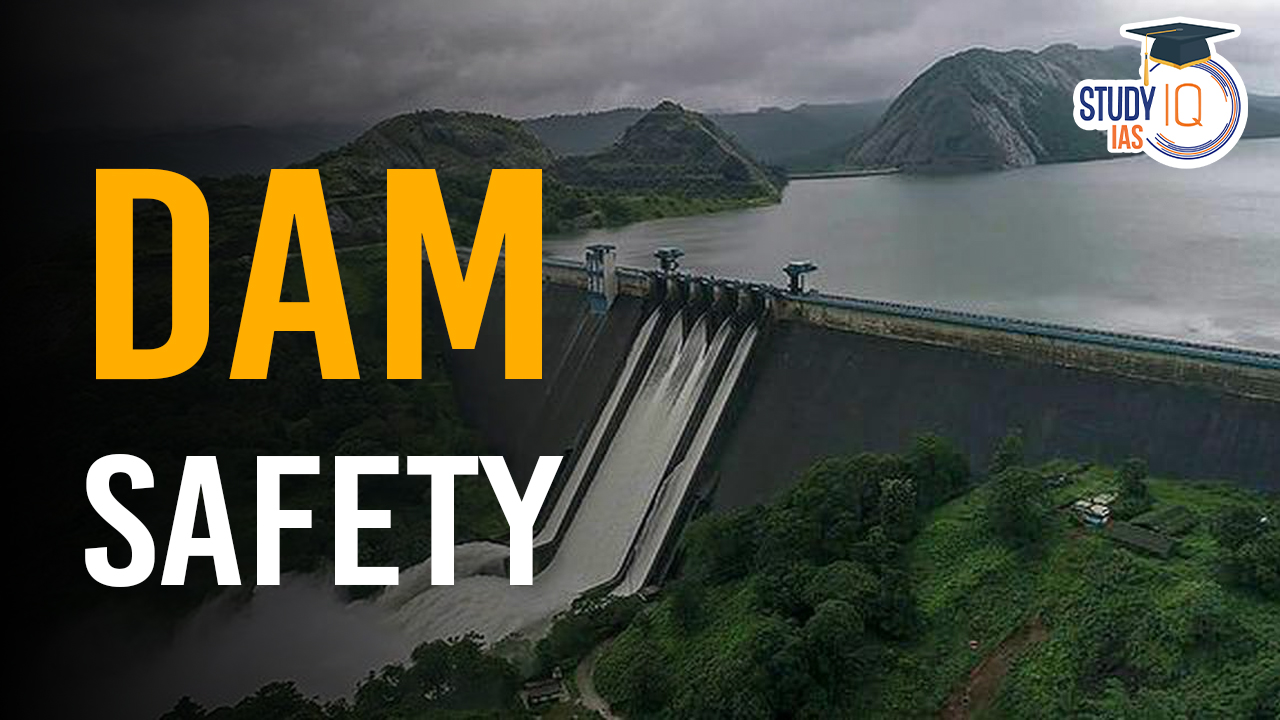Table of Contents
Context
- A team of geologists from the National Centre for Earth Science Studies (NCESC) surveyed the landslide-hit zone.
- They suggested that a heavy rainfall-induced “damming effect” in a densely forested and uninhabited uphill region caused the earthfall.
Dam Failures in India
- Dam failure refers to the catastrophic or unexpected breach of a dam structure, resulting in the uncontrolled release of water stored in the reservoir behind it.
Recent Examples of Dam Failures in India
| Dam Incident | Location and Date | Consequences |
| Kopili Hydropower Dam Disaster | Assam, March 2022 | Killed three employees of the hydroelectricity plant |
| Pulichintala Irrigation Project Incident | Krishna River, upstream of Prakasam Barrage, 2021 | Flood-like situations |
| Tiware Dam Breach | Ratnagiri, Maharashtra, July 2019 | Flooded seven villages, 20 people swept away |
Causes of Dam Failure
- Natural causes:
- Heavy rainfall leads to excessive inflow of water exceeding the dam’s capacity. For e.g., the Tiware dam failure in Ratnagiri, Maharashtra, 2019 occurred due to heavy rainfall.
- Earthquakes cause ground shaking and damage to the dam structure. For e.g., Koyna Dam failure, 1967
- Landslides impact the stability of the dam or block the flow of water
- Technical
- Foundation problems: The dam may be unstable if the soil beneath it is weak or unstable. This could happen if the soil settles, erodes, or changes its water content.
- Seepage and internal erosion: Excessive seepage of water through the dam or its foundation, cause erosion of the materials and potential weakening of the structure.
- Over-topping: When water rises above the crest of the dam due to extreme inflow or inadequate spillway capacity, it results in uncontrolled flow over the top of the dam.
- Human Error and Negligence
- Design and construction flaws: Poor design choices do not adequately consider the site conditions, hydrological factors, or potential risks. Inadequate construction practices, such as improper compaction of materials or insufficient reinforcement. For e.g., Karam dam failure in Madhya Pradesh, 2022
- Operational failures: Improper operation of the dam, including inadequate release of water during periods of high inflow or failure to adjust for changing conditions.
- Ageing infrastructure: Lack of regular inspections, maintenance, and repairs. For e.g., dam failure at Pulichintala Irrigation Project on Krishna River, Andhra Pradesh, 2021.
Impact of Dam Failure
- Loss of Life and Injuries: Dam failures lead to loss of life, injuries, and trauma due to sudden water release.
- Infrastructure Damage: Failed dams severely damage downstream structures like buildings, roads, and bridges.
- Floods and Displacement: Dam failures cause downstream flooding, displacing people and impacting livelihoods.
- Environmental Damage: Dam failures have detrimental effects on the environment, including the destruction of ecosystems, habitats, and biodiversity.
- The sudden release of water, sediment, and debris disrupt the natural flow patterns of rivers and streams, impacting aquatic life and vegetation.
- Dam failures contaminate water with pollutants, affecting human and aquatic health.
- Economic Costs: They result in financial losses from property damage, disrupted transport, and costly recovery efforts.
- Social and psychological impact: Dam failures have profound social and psychological effects on affected communities, leading to trauma, displacement, loss of community cohesion, and long-term emotional distress.
Initiatives Taken in India for Dam Safety
- Dam Safety Act 2021: The Act aims to ensure surveillance, inspection, operation and maintenance of the specified dam for prevention of dam failure-related disasters.
- Institutions under this Act: It establishes National Committee on Dam Safety (NCDS), National Dam Safety Authority (NDSA) and State Dam Safety Organizations (SDSO).
| National Committee on Dam Safety (NCDS)
|
● Headed by: Chairman of Central Water Commission (CWC)
● Objective: To help evolve uniform dam safety policies, protocols and procedures |
| National Dam Safety Authority (NDSA)
|
● Headed by: Chairman
● Function: To function as a regulating body for ensuring the nationwide implementation of dam safety policies and standards, resolve disputes between SDSOs and dam owners |
- Dam safety unit and emergency action plan: Dam owners must establish a dam safety unit within each dam.
- The unit will conduct inspections before and after the monsoon season, during and after calamities, and signs of distress.
- Preparation of emergency action plans and regular risk assessment studies are also required.
- Dam safety evaluation and expert panels: Dam owners must conduct comprehensive dam safety evaluations at specified intervals, involving expert panels.
- Offences and compliance: The act addresses two types of offences: obstruction of a person’s duties and non-compliance with issued directions.
- Dam Safety Rehabilitation and Improvement Project (DRIP): Launched in 2012 by the Central Water Commission (CWC) with World Bank support, it aims at rehabilitation of old dams in the country that may be experiencing distress and are in need of attention for ensuring their structural safety and operational efficiency.
- The scheme focuses on 4 areas: rehabilitating dams for improved safety and performance, strengthening dam safety institutions at state and central levels, generating revenue for dam maintenance, and project management.
- Dam Health and Rehabilitation Monitoring Application (DHARMA): Developed by CWC, it is a web tool to digitise all dam related data effectively.
- It helps to document authentic asset and safety & structural information pertaining to the large dams in the country, enabling appropriate actions to ensure need-based rehabilitation.
- Seismic Hazard Assessment Information System (SHAISYS): Developed by CWC, it is a web based interactive application tool for estimation of seismic hazard at any specific location in the country.
Issues with Dam Safety in India
- Inadequate Risk-Based Decision-Making: The Dam Safety Act (DSA) in India does not sufficiently promote risk-based decision-making, leading to blind spots in both legislation and implementation.
- This lack of focus on risk assessment contributes to recurring disasters.
- Compromised Transparency in National and State Bodies: The composition of national and state dam safety bodies, often consisting of government employees and engineers who have worked on the projects, hinders objective decision-making.
- This structure lacks independent voices and transparency, essential for effective dam safety management.
- Inadequate Maintenance and Inspection: There is often a lack of consistent and thorough maintenance and inspection routines, leading to unnoticed structural weaknesses and potential hazards.
- Limited Public Access to Information: Crucial information about dam safety, including reports, decisions, and committee actions, is not readily available to the public.
- Lack of Standardization in Dam Safety Evaluations: The Dam Safety Act’s effectiveness is undermined by inconsistent standards in analysing and reporting dam failures, leading to varied interpretations and approaches.
Way Forward
- Enhanced Maintenance and Inspection Routines: Regular and thorough maintenance and inspection of dams must be mandated.
- This includes adopting modern technologies for monitoring dam health and early warning systems.
- Establishing Standardised Protocols: It is necessary to implement uniform standards for analysing and reporting dam failures.
- This would ensure consistency in evaluations, facilitating better understanding and management of risks.
- Risk-Based Decision Making: It is important to incorporate risk-based decision-making in dam safety practices.
- This approach should prioritise dams based on their potential risk to life and property, ensuring that the most critical structures receive immediate attention.
- Climate Change Adaptation: Upgrading existing dams and designing new ones to withstand the changing hydrological patterns due to climate change is crucial.
- This includes accommodating increased rainfall variability and flood events.
- Promoting Transparency and Public Engagement: Safety reports, committee decisions, and risk assessments should be made publicly available.
- Further, local communities should be involved in the decision-making process.


 UDAN Scheme, Objectives, Funding and Ach...
UDAN Scheme, Objectives, Funding and Ach...
 Indus Water Treaty 1960 Suspended by Ind...
Indus Water Treaty 1960 Suspended by Ind...
 5 Years of SVAMITVA Scheme and Its Benef...
5 Years of SVAMITVA Scheme and Its Benef...





















